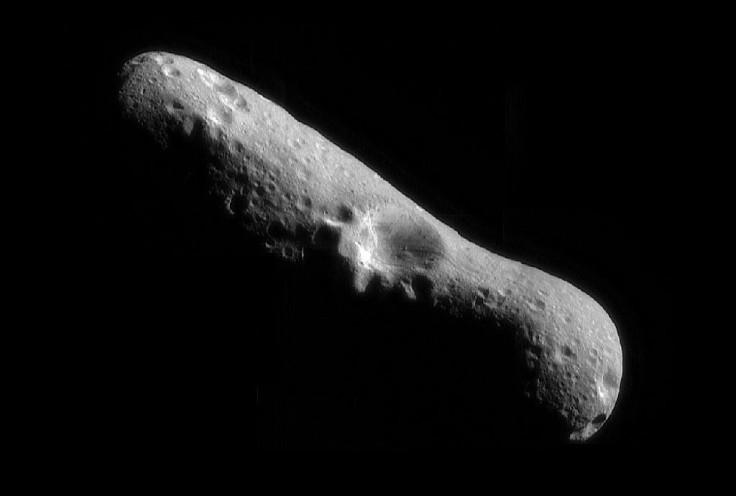Discovery Of Cigar-Shaped Asteroid From Outer Space Could Help Unveil Secrets of Extrasolar Worlds

It came from outer space … and went back there two weeks later, having astonished and excited astronomers and planetary scientists. A cigar-shaped object, less than half a kilometer long and barely bright enough to be detected by the world’s most powerful telescopes, paid us a flying visit in October this year – reminding us that the heavens still hold plenty of surprises.
There have been amazing changes in the way we view the smaller bodies in the solar system over the last five years. The Rosetta spacecraft’s observations of the duck-shaped comet 67P Churyumov-Gerasimenko taught us a lot. Similarly, the heart-shaped ice-covered plains of Pluto photographed by New Horizons and the bright spots on Ceres, as imaged by the Dawn mission, have forced us to revise our ideas of the formation and evolution of comets, asteroids and faraway dwarf planets – and the relationship between them.
Now, courtesy, not of instruments onboard spacecraft, but of detectors firmly based on the ground, we have observations of something that seems to be somewhere in the spectrum between comet and asteroid – but with a strange orbit that sets it apart from any other body in the solar system.
The orbit is hyperbolic, the object entered the solar system at a very steep angle to the ecliptic plane. It then rounded the sun, dipping below the ecliptic as it did so, and shot out again. What makes this orbit so interesting is that when its trajectory is traced back, it is clear that the object did not originate within the solar system – not even within the “Oort Cloud”, the reservoir that marks the outer fringes of our planetary system.
The mystery visitor comes from beyond the fringe, and so is interstellar. This is the first time scientists have discovered an asteroid from outside the solar system, and the finding has been published in Nature.
Window On Extrasolar Worlds
In honor of this interstellar tourist – and perhaps in the hope that we might start to observe more of them, the International Astronomical Union has come up with a new cataloguing system for interstellar asteroids. It is designated I1/2017U1, with the “I” for interstellar and “1” because it is the first. The interstellar object was detected by the PanSTARRS1 telescope on Hawaii, with follow-up observations on five other major telescopes. The discoverers of I1/2017U1 have named it “‘Oumuamua” – a Hawaiian-based word meaning a messenger reaching out from the distant past.
'Oumuamua has an odd shape – about 800 meters long and ten times as long as it is wide. And although its hyperbolic orbit originally led observers to conclude that it was a comet, additional images showed no trace of a comet tail, and it was reclassified as an interstellar asteroid. It is likely comprised of rock and perhaps metals. Spectra, images of light captured from an object and spread out according to its wavelengths, reveal that its surface is reddish. This is the case for both some comets or a certain class of asteroids (D-class).
So, we have a small, dim, fast-moving object – why should we get excited? Let’s be grandiose about it – after all, practically every article following discovery of gravitational waves declared that this was “opening a new window on the universe”. And, given its orbit, surely 'Oumuamua is worthy of similar hyperbole? I reckon we can say that the object is “illuminating the path to extrasolar worlds”, although we probably will not be able to trace exactly which planetary system it comes from. It shows that planetary systems around other stars are likely to have formed in a similar way to our own, ejecting fragments of rock like 'Oumuamua.
Planetary scientists study comets and asteroids because they are almost unchanged records of the material from which the solar system formed. Carbon-rich meteorites derived from certain asteroids contain organic matter that, when delivered to Earth by impact in the earliest days of terrestrial history, could have been the precursor material from which life developed. Such meteorites also contain small quantities of interstellar organics from reactions in the interstellar medium.
It is possible that 'Oumuamua and objects like it could carry similar records of their stellar formation. And it is also possible that there are many such objects hurtling through the solar system. As instruments on telescopes get more powerful, we will be able to detect them more readily and even make spectral measurements of their composition. This is exciting, as they almost certainly have different compositions than our own – shedding light on how the extrasolar system they came from formed.
As William Shakespeare wrote over 400 years ago:
And therefore as a stranger give it welcome.
There are more things in heaven and earth, Horatio,
Than are dreamt of in your philosophy.
Monica Grady is a Professor of Planetary and Space Sciences, at The Open University
This article was originally published in The Conversation. Read the original article.





















